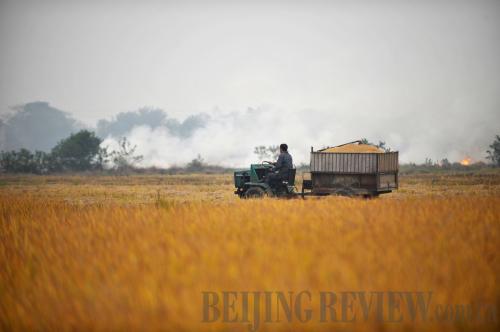
GOLDEN FIELDS: A farmer transports newly harvested rice on October 28 in Wangcheng District, Changsha, Hunan Province (XINHUA)
Now a museum covers the site, exhibiting cultural relics excavated here. What's more, a studio has been opened alongside, providing pottery lessons to children and tourists.
"On the weekend, I often take my son here to make pottery. He has great fun," said Mo Xianfeng, an English teacher at a middle school in the city, and also the mother of an 11-year-old.
"See those pottery wares?" said Mo, pointing to shelves in the studio that carry ashtrays, pencil cases and cups, etc. Some are not perfect, but still lovely.
"They were all made by tourists. My son can also make those now," Mo said with a proud smile.
According to her, many parents bring their children here on weekends for lessons and have great fun.
Tea serves as another important part of the local culture. Here tourists can savour sesame tea, made from sesame, beans, peanuts, ginger and salt. Locals drink it every day to drive away the cold and keep healthy according to Chinese medicinal traditions.
In addition, people here drink ceremonial black tea, which tourists can also experience.
"I love Chinese tea culture very much. Ceremonies are like a ballet. It demands coordinated body movements. It's so delicate and elegant," said Magdalena Kachniewska, a professor with the Department of Tourism, Warsaw School of Economics, Poland, who attended a tea ceremony in a local village on October 25.
The importance of culture in agritourism was agreed at the summit. "Tourism should always protect and preserve mother nature, culture, tradition and heritage," said Malaysian Tourism Minister Ng Yen Yen.
Economic benefit
"Agritourism also increases the income of farmers," said Yin, former Executive Vice Minister of Agriculture.
According to local government statistics, Wangcheng receives more than 6 million tourists annually, and has realized consolidated tourism revenue of 30 million yuan ($4.76 million). In recent years, the average annual growth rate of farmers' net income has reached over 20 percent.
Talking about agritourism's contribution to the increase of farmers' income, Jinggang Ancient Town serves as an excellent example. During the National Day holiday, a peak tourism period in China, a shop could sell about 400 cups of sesame tea a day, for 5 yuan ($0.82) each. It could also sell around 3,000 to 4,000 bowls of rice wine a day, for 3 yuan ($0.49) each. Locals have benefited greatly from agritourism.
Indeed, the economic benefits of agritourism have encouraged many countries across the world.
"Our experience in recent years proves agritourism drives agricultural development. It can increase income, promote employment and ensure good operation of rural communities. In Italy, agritourism has surged in recent years. During 2012, rural areas received about 3 million tourists," said Maurizio Martina, Italian Vice Minister of Agricultural Policies, Food and Forestry, on October 27.
Indeed, Changsha regards agritourism as a significant means to realize urban-rural integration. "We will explore balanced development between urban and rural areas with Changsha features," said Yi, Party chief of the city.
According to Yi, the city has strengthened investment in agritourism to balance urban and rural development. The Wangcheng District is a focus of such initiative, which has born remarkable fruit.
Since 2009, the district's GDP and per-capita equivalent has achieved an annual growth rate of 16.1 and 28 percent, respectively, while its competitiveness jumped to No. 2 in the province. The per-capita net income of farmers in 2011 was twice the national average, with an annual growth rate of 21.2 percent. During the first half of 2012, the annual growth rate hit 30.4 percent, far higher than the national figure.
Now the district has become a successful model for China's central and western regions, especially suburban districts and counties near big cities in terms of developing rural economies with local features and coordinating urban-rural economic growth.
We recommend:
